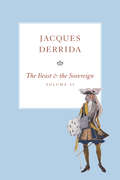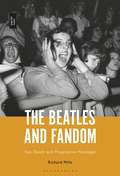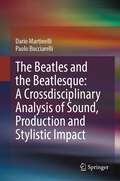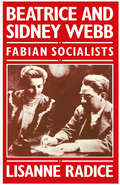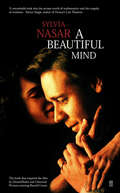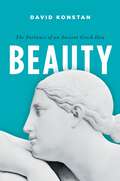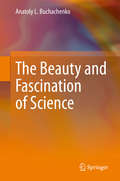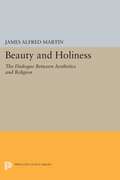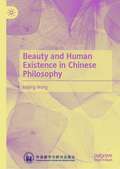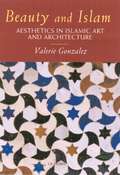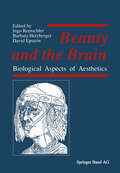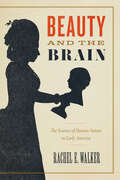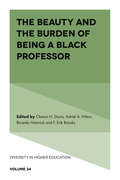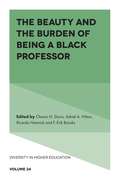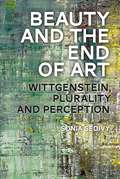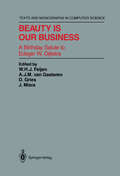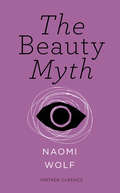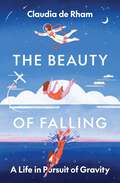- Table View
- List View
The Beast and the Sovereign, Volume II (The Seminars of Jacques Derrida #v. 1)
by Jacques DerridaFollowing on from The Beast and the Sovereign, Volume I, this book extends Jacques Derrida’s exploration of the connections between animality and sovereignty. In this second year of the seminar, originally presented in 2002–2003 as the last course he would give before his death, Derrida focuses on two markedly different texts: Heidegger’s 1929–1930 course The Fundamental Concepts of Metaphysics, and Daniel Defoe’s Robinson Crusoe. As he moves back and forth between the two works, Derrida pursuesthe relations between solitude, insularity, world, violence, boredom and death as they supposedly affect humans and animals in different ways. Hitherto unnoticed or underappreciated aspects of Robinson Crusoe are brought out in strikingly original readings of questions such as Crusoe’s belief in ghosts, his learning to pray, his parrot Poll, and his reinvention of the wheel. Crusoe’s terror of being buried alive or swallowed alive by beasts or cannibals gives rise to a rich and provocative reflection on death, burial, and cremation, in part provoked by a meditation on the death of Derrida’s friend Maurice Blanchot. Throughout, these readings are juxtaposed with interpretations of Heidegger's concepts of world and finitude to produce a distinctively Derridean account that will continue to surprise his readers.
The Beast and the Sovereign, Volume II (The Seminars of Jacques Derrida #v. 1)
by Jacques DerridaFollowing on from The Beast and the Sovereign, Volume I, this book extends Jacques Derrida’s exploration of the connections between animality and sovereignty. In this second year of the seminar, originally presented in 2002–2003 as the last course he would give before his death, Derrida focuses on two markedly different texts: Heidegger’s 1929–1930 course The Fundamental Concepts of Metaphysics, and Daniel Defoe’s Robinson Crusoe. As he moves back and forth between the two works, Derrida pursuesthe relations between solitude, insularity, world, violence, boredom and death as they supposedly affect humans and animals in different ways. Hitherto unnoticed or underappreciated aspects of Robinson Crusoe are brought out in strikingly original readings of questions such as Crusoe’s belief in ghosts, his learning to pray, his parrot Poll, and his reinvention of the wheel. Crusoe’s terror of being buried alive or swallowed alive by beasts or cannibals gives rise to a rich and provocative reflection on death, burial, and cremation, in part provoked by a meditation on the death of Derrida’s friend Maurice Blanchot. Throughout, these readings are juxtaposed with interpretations of Heidegger's concepts of world and finitude to produce a distinctively Derridean account that will continue to surprise his readers.
The Beast and the Sovereign, Volume II: Beast And The Sovereign (The Seminars of Jacques Derrida #v. 1)
by Jacques DerridaFollowing on from The Beast and the Sovereign, Volume I, this book extends Jacques Derrida’s exploration of the connections between animality and sovereignty. In this second year of the seminar, originally presented in 2002–2003 as the last course he would give before his death, Derrida focuses on two markedly different texts: Heidegger’s 1929–1930 course The Fundamental Concepts of Metaphysics, and Daniel Defoe’s Robinson Crusoe. As he moves back and forth between the two works, Derrida pursuesthe relations between solitude, insularity, world, violence, boredom and death as they supposedly affect humans and animals in different ways. Hitherto unnoticed or underappreciated aspects of Robinson Crusoe are brought out in strikingly original readings of questions such as Crusoe’s belief in ghosts, his learning to pray, his parrot Poll, and his reinvention of the wheel. Crusoe’s terror of being buried alive or swallowed alive by beasts or cannibals gives rise to a rich and provocative reflection on death, burial, and cremation, in part provoked by a meditation on the death of Derrida’s friend Maurice Blanchot. Throughout, these readings are juxtaposed with interpretations of Heidegger's concepts of world and finitude to produce a distinctively Derridean account that will continue to surprise his readers.
The Beatles and Fandom: Sex, Death and Progressive Nostalgia
by Richard MillsSex, death and nostalgia are among the impulses driving Beatles fandom: the metaphorical death of the Beatles after their break-up in 1970 has fueled the progressive nostalgia of fan conventions for 48 years; the death of John Lennon and George Harrison has added pathos and drama to the Beatles' story; Beatles Monthly predicated on the Beatles' good looks and the letters page was a forum for euphemistically expressed sexuality. The Beatles and Fandom is the first book to discuss these fan subcultures. It combines academic theory on fandom with compelling original research material to tell an alternative history of the Beatles phenomenon: a fans' history of the Beatles that runs concurrently with the popular story we all know.
The Beatles and Fandom: Sex, Death and Progressive Nostalgia
by Richard MillsSex, death and nostalgia are among the impulses driving Beatles fandom: the metaphorical death of the Beatles after their break-up in 1970 has fueled the progressive nostalgia of fan conventions for 48 years; the death of John Lennon and George Harrison has added pathos and drama to the Beatles' story; Beatles Monthly predicated on the Beatles' good looks and the letters page was a forum for euphemistically expressed sexuality. The Beatles and Fandom is the first book to discuss these fan subcultures. It combines academic theory on fandom with compelling original research material to tell an alternative history of the Beatles phenomenon: a fans' history of the Beatles that runs concurrently with the popular story we all know.
The Beatles and the Beatlesque: A Crossdisciplinary Analysis of Sound Production and Stylistic Impact
by Dario Martinelli Paolo BucciarelliThe Beatles and the Beatlesque address a paradox emanating from The Beatles’ music through a cross-disciplinary hybrid of reflections, drawing from both, musical practice itself and academic research. Indeed, despite their extreme stylistic variety, The Beatles’ songs seem to always bear a distinctive identity that emerges even more in similar works by other artists, whether they are merely inspired, derivative or explicitly paying homage. The authors, a musicologist and music producer, emphasize the importance of record production in The Beatles' music in a way that does justice not only to the final artifacts (the released songs) but also to the creative process itself (i.e., the songs "in the making").Through an investigation into the work of George Martin and his team, as well as The Beatles themselves, this text sheds light on the role of the studio in shaping the group's eclectic but unique sound. The chapters address what makes a song “Beatlesque”, to what extent production choices are responsible for developing a style, production being understood not as a mere set of technicalities, but also in a more conceptual way, as well as the aesthetics, semiotics and philosophy that animated studio activity. The outcome is a book that will appeal to both students and researchers, as well as, of course, musicophiles of all kinds.
Beautiful Geometry
by Eli Maor Eugen JostIf you've ever thought that mathematics and art don't mix, this stunning visual history of geometry will change your mind. As much a work of art as a book about mathematics, Beautiful Geometry presents more than sixty exquisite color plates illustrating a wide range of geometric patterns and theorems, accompanied by brief accounts of the fascinating history and people behind each. With artwork by Swiss artist Eugen Jost and text by math historian Eli Maor, this unique celebration of geometry covers numerous subjects, from straightedge-and-compass constructions to intriguing configurations involving infinity. The result is a delightful and informative illustrated tour through the 2,500-year-old history of one of the most important branches of mathematics.
Beautiful Geometry (PDF)
by Eli Maor Eugen JostIf you've ever thought that mathematics and art don't mix, this stunning visual history of geometry will change your mind. As much a work of art as a book about mathematics, Beautiful Geometry presents more than sixty exquisite color plates illustrating a wide range of geometric patterns and theorems, accompanied by brief accounts of the fascinating history and people behind each. With artwork by Swiss artist Eugen Jost and text by math historian Eli Maor, this unique celebration of geometry covers numerous subjects, from straightedge-and-compass constructions to intriguing configurations involving infinity. The result is a delightful and informative illustrated tour through the 2,500-year-old history of one of the most important branches of mathematics.
A Beautiful Mind (Shooting Script Ser.)
by Sylvia NasarA Beautiful Mind is Sylvia Nasar's award-winning biography about the mystery of the human mind, the triumph over incredible adversity, and the healing power of love.At the age of thirty-one, John Nash, mathematical genius, suffered a devastating breakdown and was diagnosed with schizophrenia. Yet after decades of leading a ghost-like existence, he was to re-emerge to win a Nobel Prize and world acclaim. A Beautiful Mind has inspired the Oscar-winning film directed by Ron Howard and featuring Russell Crowe in the lead role of John Nash.
Beauty: The Fortunes of an Ancient Greek Idea (Onassis Series in Hellenic Culture)
by David KonstanWhat does it mean to say something is beautiful? On the one hand, beauty is associated with erotic attraction; on the other, it is the primary category in aesthetics, and it is widely supposed that the proper response to a work of art is one of objective contemplation. At its core, then, beauty is a contested concept, and both sides feel comfortable appealing to the authority of Plato, and via him, to the ancient Greeks generally. So, who is right-if either? Beauty offers an elegant investigation of ancient Greek notions of beauty and, in the process, sheds light on how we ought to appreciate the artistic achievements of the classical world. The book opens by reexamining the commonly held notion that the ancient Greeks possessed no term that can be unambiguously defined as "beauty" or "beautiful." Author David Konstan discusses a number of Greek approximations before positioning the heretofore unexamined term kállos as the key to bridging the gap between beauty and desire, and tracing its evolution as applied to physical beauty, art, literature, and more. The book then examines corresponding terms in Biblical Hebrew and ancient Latin literature to highlight the survival of Greek ideas in the Latin West. The final chapter compares the ancient Greek conception of beauty with modern notions of beauty and aesthetics. In particular, it focuses on the reception of classical Greek art in the Renaissance and how Vasari and his contemporaries borrowed from Plato the sense that the beauty in art was transcendental, but left out the erotic dimension of viewing. Even if Greece was the inspiration for modern aesthetic ideals, this study illustrates how the Greek view of the relationship between beauty and desire was surprisingly consistent-and different from our own. This fascinating and magisterial exploration makes it possible to identify how the Greeks thought of beauty, what it was that attracted them, and what their perceptions can still tell us about art, love, desire-and beauty.
Beauty: The Fortunes of an Ancient Greek Idea (Onassis Series in Hellenic Culture)
by David KonstanWhat does it mean to say something is beautiful? On the one hand, beauty is associated with erotic attraction; on the other, it is the primary category in aesthetics, and it is widely supposed that the proper response to a work of art is one of objective contemplation. At its core, then, beauty is a contested concept, and both sides feel comfortable appealing to the authority of Plato, and via him, to the ancient Greeks generally. So, who is right-if either? Beauty offers an elegant investigation of ancient Greek notions of beauty and, in the process, sheds light on how we ought to appreciate the artistic achievements of the classical world. The book opens by reexamining the commonly held notion that the ancient Greeks possessed no term that can be unambiguously defined as "beauty" or "beautiful." Author David Konstan discusses a number of Greek approximations before positioning the heretofore unexamined term kállos as the key to bridging the gap between beauty and desire, and tracing its evolution as applied to physical beauty, art, literature, and more. The book then examines corresponding terms in Biblical Hebrew and ancient Latin literature to highlight the survival of Greek ideas in the Latin West. The final chapter compares the ancient Greek conception of beauty with modern notions of beauty and aesthetics. In particular, it focuses on the reception of classical Greek art in the Renaissance and how Vasari and his contemporaries borrowed from Plato the sense that the beauty in art was transcendental, but left out the erotic dimension of viewing. Even if Greece was the inspiration for modern aesthetic ideals, this study illustrates how the Greek view of the relationship between beauty and desire was surprisingly consistent-and different from our own. This fascinating and magisterial exploration makes it possible to identify how the Greeks thought of beauty, what it was that attracted them, and what their perceptions can still tell us about art, love, desire-and beauty.
The Beauty and Fascination of Science
by Anatoly L. BuchachenkoIn this book, Professor Anatoly Buchachenko gives a brief and informative description of the most striking achievements and discoveries made in the major natural sciences at the turn of the century – in the late twentieth and early twenty-first centuries. The author has a rare ability to describe scientific discoveries so that these achievements and their significance are understandable not only by professionals and scientists of all specialities, but for any reader interested in modern science, its role in the existence of mankind, and its impact on human society. Originally published in Russian, Professor Buchachenko’s book describes the interaction of natural sciences with social ones—philosophy and history—as well as the part played by the human factor in the development of science, especially the role of the great scientists.
Beauty and Holiness: The Dialogue Between Aesthetics and Religion (PDF)
by James Alfred MartinIn this broad historical and critical overview based on a lifetime of scholarship, James Alfred Martin, Jr., examines the development of the concepts of beauty and holiness as employed in theories of aesthetics and of religion. The injunction in the Book of Psalms to "worship the Lord in the beauty of holiness" addressed a tradition that has comprehended holiness primarily in terms of ethical righteousness--a conception that has strongly influenced Western understandings of religion. As the author points out, however, the Greek forbears of Western thought, as well as many Eastern traditions, were and are more broadly concerned with the pursuit of beauty, truth, and goodness as ideals of human excellence, that is, with the "holiness of beauty." In this work Martin describes a philosophical stance that should prove to be most productive for the dialogue between aesthetics and religion.Beginning with the treatment of beauty and holiness in Hebrew, Greek, and classical Christian thought, the author traces the emergence of modern theories of aesthetics and religion in the Enlightenment. He then outlines the role of aesthetics in the theories of religion proposed by Otto, Eliade, van der Leeuw, and Tillich, in the cultural anthropology of Geertz, and in the thought of Santayana, Dewey, Whitehead, Heidegger, and Wittgenstein. In a global context Martin explores the relation of aesthetic theory to religious thought in the traditions of India, China, and Japan and concludes with reflections on the viability of modern aesthetic and religious theory in the light of contemporary cultural and methodological pluralism.Originally published in 1990.The Princeton Legacy Library uses the latest print-on-demand technology to again make available previously out-of-print books from the distinguished backlist of Princeton University Press. These editions preserve the original texts of these important books while presenting them in durable paperback and hardcover editions. The goal of the Princeton Legacy Library is to vastly increase access to the rich scholarly heritage found in the thousands of books published by Princeton University Press since its founding in 1905.
Beauty and Human Existence in Chinese Philosophy
by Keping WangThis book considers the Chinese conception of beauty from a historical perspective with regard to its significant relation to human personality and human existence. It examines the etymological implications of the pictographic character mei, the totemic symbolism of beauty, the ferocious beauty of the bronzeware. Further on, it proceeds to look into the conceptual progression of beauty in such main schools of thought as Confucianism, Daoism and Chan Buddhism. Then, it goes on to illustrate through art and literature the leading principles of equilibriumharmony, spontaneous naturalness, subtle void and synthetic possibilities. It also offers a discussion of modern change and transcultural creation conducted with particular reference to the theory of the poetic state par excellence (yi jing shuo) and that of art as sedimentation (ji dian shuo).
Beauty and Islam: Aesthetics in Islamic Art and Architecture
by Valerie GonzalezThis illustrated volume of five essays explores aspects of aesthetics in classical Islamic thought in the light of contemporary theories, offering new perspectives on Islamic art and architecture with examples ranging from the Qur'an and the Alhambra to the works of present day artists and philosophers. Tracing the roots of Islamic aesthetics back to the works of the great philosophers of the Middle Ages such as Avicenna and Averroes, Gonzalez finds that aesthetic theory in Islam must be seen within the much wider context of parallel thinking on theology, ethics, physics and metaphysics. She balances her analysis of this philosophy (moral, logical and scientific) of beauty with the equally important analysis of the perceptual experience of beauty. Her study covers the breadth and depth of the experience, understanding and formulation of beauty as it has been seen through Islamic eyes.
Beauty and the Brain: The Science of Human Nature in Early America
by Rachel E. WalkerExamining the history of phrenology and physiognomy, Beauty and the Brain proposes a bold new way of understanding the connection between science, politics, and popular culture in early America. Between the 1770s and the 1860s, people all across the globe relied on physiognomy and phrenology to evaluate human worth. These once-popular but now discredited disciplines were based on a deceptively simple premise: that facial features or skull shape could reveal a person’s intelligence, character, and personality. In the United States, these were culturally ubiquitous sciences that both elite thinkers and ordinary people used to understand human nature. While the modern world dismisses phrenology and physiognomy as silly and debunked disciplines, Beauty and the Brain shows why they must be taken seriously: they were the intellectual tools that a diverse group of Americans used to debate questions of race, gender, and social justice. While prominent intellectuals and political thinkers invoked these sciences to justify hierarchy, marginalized people and progressive activists deployed them for their own political aims, creatively interpreting human minds and bodies as they fought for racial justice and gender equality. Ultimately, though, physiognomy and phrenology were as dangerous as they were popular. In addition to validating the idea that external beauty was a sign of internal worth, these disciplines often appealed to the very people who were damaged by their prejudicial doctrines. In taking physiognomy and phrenology seriously, Beauty and the Brain recovers a vibrant—if largely forgotten—cultural and intellectual universe, showing how popular sciences shaped some of the greatest political debates of the American past.
The Beauty and the Burden of Being a Black Professor (Diversity in Higher Education #24)
by Cheron H. Davis, Adriel Hilton, Ricardo Hamrick, F. Erik BrooksIt has been well chronicled that Black professors have experienced a long history of inequities and inequalities within the academic space. This volume explores the experiences, challenges and triumphs experienced by Black professors. Including personal essays written by Black professors, this volume showcases personal insights and inspirational stories from leading Black scholars across the US. It highlights and problematizes the uncomfortable truth of the lack of diversity in many higher education institutions in order to further discussions on the topic of race in academia, and to assist academics of color in preparing for their careers. Future academics will gain a sense of how to launch their careers, stay productive in research, teaching and service, and avoid the racial-related malaise that can hinder new academics of color. By presenting discussions on professional development, and emphasizing the challenges and triumphs experienced by Black professors across disciplines, this book provides advice for junior Black scholars on how to navigate academe and tackle the challenges that Black scholars often face.
The Beauty and the Burden of Being a Black Professor (Diversity in Higher Education #24)
by Cheron H. Davis Adriel A. Hilton Ricardo Hamrick F. Erik BrooksIt has been well chronicled that Black professors have experienced a long history of inequities and inequalities within the academic space. This volume explores the experiences, challenges and triumphs experienced by Black professors. Including personal essays written by Black professors, this volume showcases personal insights and inspirational stories from leading Black scholars across the US. It highlights and problematizes the uncomfortable truth of the lack of diversity in many higher education institutions in order to further discussions on the topic of race in academia, and to assist academics of color in preparing for their careers. Future academics will gain a sense of how to launch their careers, stay productive in research, teaching and service, and avoid the racial-related malaise that can hinder new academics of color. By presenting discussions on professional development, and emphasizing the challenges and triumphs experienced by Black professors across disciplines, this book provides advice for junior Black scholars on how to navigate academe and tackle the challenges that Black scholars often face.
Beauty and the End of Art: Wittgenstein, Plurality and Perception
by Sonia SedivyBeauty and the End of Art shows how a resurgence of interest in beauty and a sense of ending in Western art are challenging us to rethink art, beauty and their relationship. By arguing that Wittgenstein's later work and contemporary theory of perception offer just what we need for a unified approach to art and beauty, Sonia Sedivy provides new answers to these contemporary challenges. These new accounts also provide support for the Wittgensteinian realism and theory of perception that make them possible.Wittgenstein's subtle form of realism explains artworks in terms of norm governed practices that have their own varied constitutive norms and values. Wittgensteinian realism also suggests that diverse beauties become available and compelling in different cultural eras and bring a shared 'higher-order' value into view. With this framework in place, Sedivy argues that perception is a form of engagement with the world that draws on our conceptual capacities. This approach explains how perceptual experience and the perceptible presence of the world are of value, helping to account for the diversity of beauties that are available in different historical contexts and why the many faces of beauty allow us to experience the value of the world's perceptible presence.Carefully examining contemporary debates about art, aesthetics and perception, Beauty and the End of Art presents an original approach. Insights from such diverse thinkers as Immanuel Kant, Hans-Georg Gadamer and Arthur Danto, Alexander Nehamas, Elaine Scarry and Dave Hickey are woven together to reveal how they make good sense if we bring contemporary theory of perception and Wittgensteinian realism into the conversation.
Beauty and the End of Art: Wittgenstein, Plurality and Perception
by Sonia SedivyBeauty and the End of Art shows how a resurgence of interest in beauty and a sense of ending in Western art are challenging us to rethink art, beauty and their relationship. By arguing that Wittgenstein's later work and contemporary theory of perception offer just what we need for a unified approach to art and beauty, Sonia Sedivy provides new answers to these contemporary challenges. These new accounts also provide support for the Wittgensteinian realism and theory of perception that make them possible.Wittgenstein's subtle form of realism explains artworks in terms of norm governed practices that have their own varied constitutive norms and values. Wittgensteinian realism also suggests that diverse beauties become available and compelling in different cultural eras and bring a shared 'higher-order' value into view. With this framework in place, Sedivy argues that perception is a form of engagement with the world that draws on our conceptual capacities. This approach explains how perceptual experience and the perceptible presence of the world are of value, helping to account for the diversity of beauties that are available in different historical contexts and why the many faces of beauty allow us to experience the value of the world's perceptible presence.Carefully examining contemporary debates about art, aesthetics and perception, Beauty and the End of Art presents an original approach. Insights from such diverse thinkers as Immanuel Kant, Hans-Georg Gadamer and Arthur Danto, Alexander Nehamas, Elaine Scarry and Dave Hickey are woven together to reveal how they make good sense if we bring contemporary theory of perception and Wittgensteinian realism into the conversation.
Beauty Is Our Business: A Birthday Salute to Edsger W. Dijkstra (Monographs in Computer Science)
by Wim Feijen A. J. M. Van Gasteren David Gries J. MisraMore than anything else, this book is a tribute to Edsger W. Dijkstra, on the occasion of his sixtieth birthday, by just a few of those fortunate enough to be influenced by him and his work and to be called his friend or relation, his master, colleague, or pupil. This book contains fifty-four technical contributions in different areas of endeavor, although many of them deal with an area of particular concern to Dijkstra: programming. Each contribution is relatively short and could be digested in one sitting. Together, they form a nice cross section of the discipline of programming at the beginning of the nineties. While many know of Dijkstra's technical contributions, they may not be aware of his ultimate goal, the mastery of complexity in mathematics and computing science. He has forcefully argued that beauty and elegance are essential to this mastery. The title of this book, chosen to reflect his ultimate goal, comes from a sentence in an article of his on some beautiful arguments using mathematical induction: "... when we recognize the battle against chaos, mess, and unmastered complexity as one of computing sci- ence's major callings, we must admit that 'Beauty Is Our Business'."
The Beauty Myth: How Images Of Beauty Are Used Against Women (Vintage Feminism Short Editions)
by Naomi WolfVintage Feminism: classic feminist texts in short formWITH A NEW INTRODUCTION BY THE AUTHOREvery day, women around the world are confronted with a dilemma – how to look. In a society embroiled in a cult of female beauty and youthfulness, pressure on women to conform physically is constant and all-pervading. In this shortened edition you will find the essence of Wolf’s groundbreaking book. It is a radical, gripping and frank exposé of the tyranny of the beauty myth, its oppressive function and the destructive obsession it engenders.
The Beauty of Falling: A Life in Pursuit of Gravity
by Claudia de RhamA world-renowned physicist seeks gravity&’s true nature and finds wisdom in embracing its force in her lifeClaudia de Rham has been playing with gravity her entire life. As a diver, experimenting with her body&’s buoyancy in the Indian Ocean. As a pilot, soaring over Canadian waterfalls on dark mornings before beginning her daily scientific research. As an astronaut candidate, dreaming of the experience of flying free from Earth&’s pull. And as a physicist, discovering new sides to gravity&’s irresistible personality by exploring the limits of Einstein&’s general theory of relativity. In The Beauty of Falling, de Rham shares captivating stories about her quest to gain intimacy with gravity, to understand both its feeling and fundamental nature. Her life&’s pursuit led her from a twist of fate that snatched away her dream of becoming an astronaut to an exhilarating breakthrough at the very frontiers of gravitational physics.While many of us presume to know gravity quite well, the brightest scientists in history have yet to fully answer the simple question: what exactly is gravity? De Rham reveals how great minds—from Newton and Einstein to Stephen Hawking, Andrea Ghez, and Roger Penrose—led her to the edge of knowledge about this fundamental force. She found hints of a hidden side to gravity at the particle level where Einstein&’s theory breaks down, leading her to develop a new theory of &“massive gravity.&” De Rham shares how her life&’s path turned from a precipitous fall to an exquisite flight toward the discovery of something entirely new about our surprising, gravity-driven universe.
